|
Last summer, my wife,
Lynn, and I dropped in on cousin Kathleen and her
husband, Ross, at their Wahwashkesh Lake cottage.
After the customary welcome refreshments and sharing
of family news and gossip, Ross and I naturally
started talking cottage stuff. I noted that he had
recently replaced the deck on the side of the
cottage. This required closer observation, so we
abandoned the women and our lawn chairs and climbed
the steps for the requisite inspection. Ross said he
was considering installing a bench along the railing
side of the deck and wanted to know what I thought.
Since this bench/table project was already under
construction back at my place, I suggested it might
be a suitable alternative. Like stationary benches,
our bench/tables provide extra deck seating space,
but they can be moved around. The added bonus is
that they can also be quickly converted to half
picnic tables or combined to form a full one. This
eliminates the need for the traditional, but
cumbersome wood picnic table or a plastic or
aluminum patio set that always seems to take up too
much space. The multi-purpose benches are the hands
(and bottoms) down way to go.
|
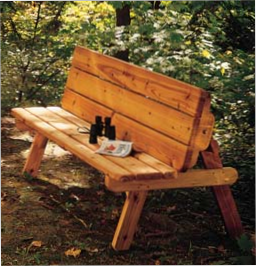 |
FRAMING/LEGS
1. Refer to the Materials List and Illust. 4, to cut
out the main parts. If you do not have a really good
sabre/jig saw, or access to a band saw, you might
want to mitre the corners instead of cutting the
curves. It is virtually impossible to keep the blade
perpendicular with a standard sabre/jig saw in 11⁄2"
lumber so save yourself the aggravation.
2. The table legs require a 11⁄2" x 31⁄2" notch for
the back brace (Illust. 4). I accomplished this with
a dado blade on my radial arm saw. However, the same
can be achieved with a circular saw (or a handsaw,
for that matter) and a sharp chisel: Make several
passes 11⁄2" deep and then remove the remaining
material with the chisel. The bottom outside corners
of all four legs for each bench are trimmed to
reduce the possibility of splitting when the table
is tipped (Illust. 4). Drill a 3⁄8" hole, centred,
31⁄2" from the top of each table leg.
3. For this project, I opted to fashion 31⁄2"-wide
half-lap joints in the bench end brackets to
increase the frame’s rigidity and strength. Remember
to make two pairs of opposing brackets (Illust. 4).
Again, the circular saw and chisel method can be
used to make the notches if you don’t have something
better. Drill the eight clearance holes in each
bracket. I rummaged around in my rather sorry
collection of bits and found only a 9⁄64" – adequate
enough for #8 screws! For looks, you can router the
outside perimeter of each bracket (Illust. 3). I
like my trusty old 1⁄2" roundover bit because it
produces such a pleasing profile.
4. Sand the bench legs, table legs, and the bench
end brackets. Attach the legs to the bench end
brackets with #8 x 2" deck screws (the
brassy-looking kind) and Type II carpenter’s glue (Illust.
1). The advantage of Type II glue is its water
resistance. However, it runs more and tends to ooze
out of the joints longer than ordinary wood glue so
you’ll need to be extra careful when wiping it up.
5. Drill the 3⁄8" holes in the table end brackets
where shown (Illust. 4). Router the outside and
inside perimeters, except along the top edges, of
the four table end and two table centre brackets.
|
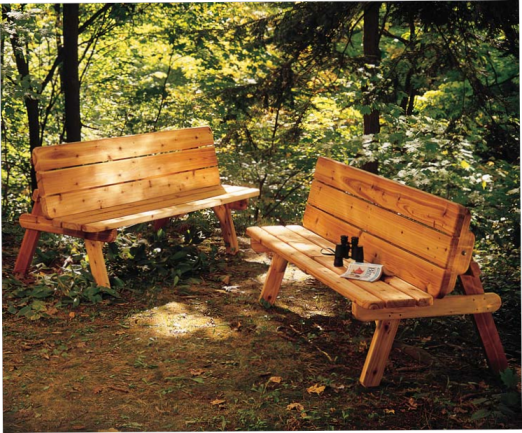 |
TABLETOP
1. Select the six best 2" x 6" x 711⁄2" boards for
the tabletops. Round the outside corners of the four
outside boards as in Illust. 2. To enable the two
benches to fit together to form a large table, the
table legs must be offset (see photo). For Bench A,
the clearance holes for the table end bracket are
located 41⁄2" from the ends of the tabletop; for
Bench B, they are drilled 61⁄2" from the end. The
holes for the centre brackets do not need to be
offset (Illust. 2). Sand the table boards and the
six table brackets. Check for square, and screw the
boards to the brackets using #8 x 3" deck screws.
Leave about a 3⁄8" gap between each board to achieve
the 17" overall width for each table (Illust. 1).
2. Turn the assembled tabletop pieces upside down.
Attach the table leg assembly to the inside of the
table end brackets with 3⁄8" x 4" carriage bolts,
washers, and compression nuts. Make it a good snug
fit (no Herc, you don’t need to crush the cedar!).
Carefully stand the benches upright, and swing the
tabletop/bench backs up into the tabletop position.
|
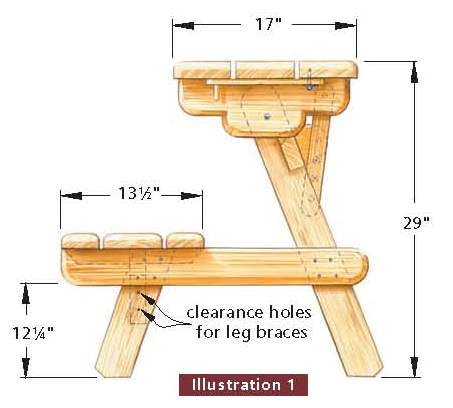 |
BENCHES
1. Select the six bench boards (four 2" x 4" x
711⁄2" and two 2" x 6" x 711⁄2"). Round the outside
corners of the four 2" x 4"s.
2. Drill the clearance holes for the bench end
brackets in the bench boards. Again, because the
frames are offset, the clearance holes for Bench A
and Bench B are different (Illust. 2). While you’re
at it, drill the clearance holes for the bench leg
braces as well. Router the top perimeter of each
board before assembly. (I, naturally, made the
mistake of assembly first; I then had to remove the
innermost boards to router them.) Ensure that the
frames are square, and screw the boards to the bench
end brackets using #8 x 3" deck screws, leaving
about 1⁄2" between boards.
3. Router the outside edges of the bench centre
brackets and the leg braces before assembly. I
screwed the brackets in from underneath; countersink
the holes a good 1⁄2" because you will only be using
#8 x 2" deck screws. Drill the clearance holes in
the bench legs (Illust. 1) and attach the bench leg
braces to the centre bench boards and to the legs
with #8 x 3" deck screws. Sand.
BACK BRACES
The back braces (Illust. 4) measure 63-3⁄4" for
Bench A and 59-3⁄4" for Bench B. Each brace extends
about 11⁄2" beyond the table legs. Notches (see
inset detail) on the extensions act as stops for the
tabletops when they are tipped up, and the
extensions themselves stop the bench backs when
they’re tipped down. The measurements given for the
notches are starting points. Begin conservatively
and whittle away a bit at a time, checking for fit
as you go. I made the initial cuts with a backsaw,
but then I had to make several fittings, adjusting
the angles with a rasp and a very sharp chisel to
get them just right; be patient. Once you’re
satisfied, check for square, sand, then glue and
screw the braces to the table legs using two #8 x 3"
deck screws at each end.
|
Free
Picnic Table Wood Plans
(Right Click on Image, and Select View as
Image or Save As to See the FULL SIZE
Picture)
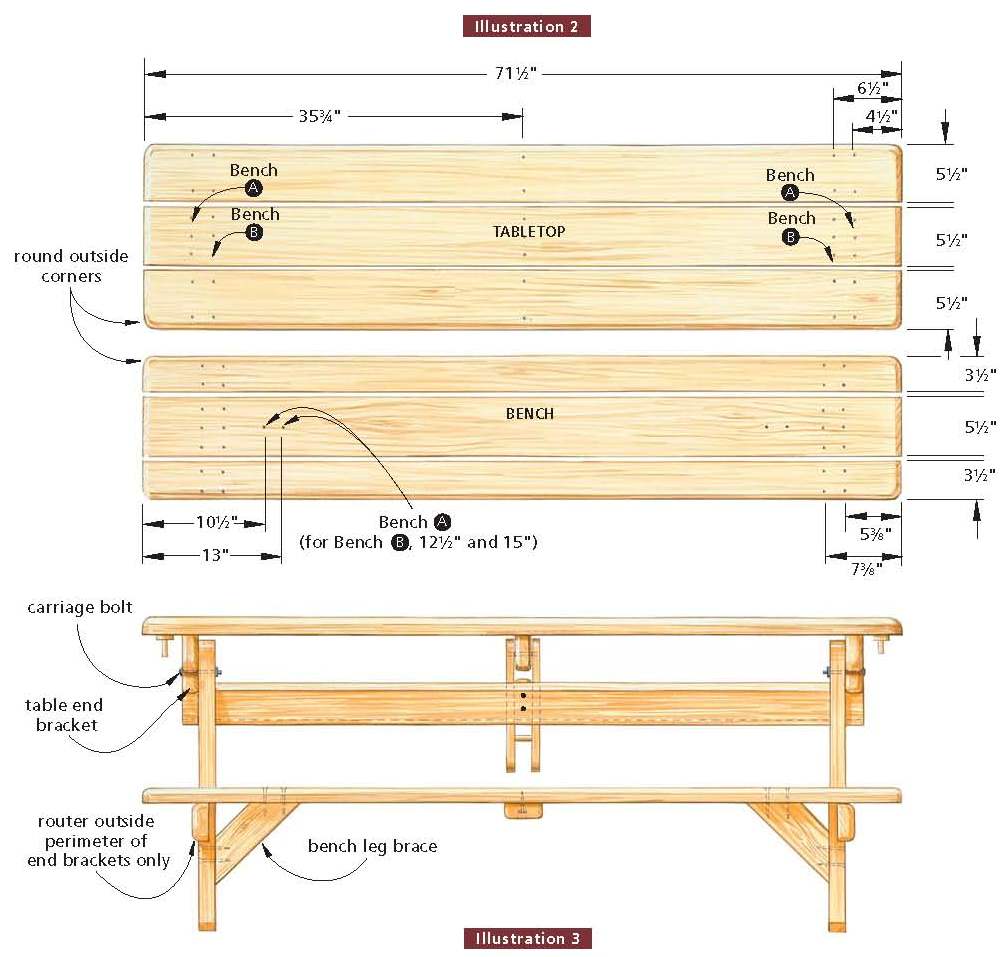 |
LOCKING MECHANISM
1. When the bench back is tilted down, it needs to
be secured; it must also be locked when it is in the
table position. Illust. 5 and 6 show details of the
locking mechanism that satisfies both requirements
(a eureka moment at five in the morning). The stop
block (Illust. 5) has been routered to match the
profile of the table centre bracket. Install it on
the back brace directly below the centre bracket
with glue and two #8 x 3" deck screws.
2. Make a 1⁄2" notch in the bottom of the stop block
with a round file or a surform tool. Taper the
leading edge of the notch to create a flat surface
that is roughly level with the tabletop. (The notch
on the top for the bench position is added later.)
3. The swingarm assemblies consist of 3⁄4" x 11⁄2" x
123⁄4" sides, rounded at the ends, and joined by
three 1⁄2" x 21⁄2" dowels, two on the bottom and one
on top. The dowels nest in 1⁄2" pockets drilled
7⁄16" deep (a forstner-type bit is ideal for this
job, as is a drill press). Drill a small clearance
hole through the centre of each pocket. This allows
excess glue to escape from the pocket during
assembly, and is the guide for the pilot holes that
you will need to drill for the #6 x 1" screws.
Temporarily assemble the swingarm by securing both
sides to the two bottom dowels only. Ours were
approximately 71⁄16" and 87⁄8" down from the top of
the arm.
4. With the bench back in the tabletop position
(clamped to hold it in place, if necessary),
position the swingarm so
that the top of the middle dowel you just installed
fits snugly into the notch you cut in the bottom of
the stop block (left- and photo, opposite). Then
slide the open upper end of the assembly over the
table centre bracket. Use a small nail or awl to
mark the position where the upper dowel will pass
through the table centre bracket (that little hole
you drilled will help. The position indicated in
Illust. 6 is approximate). Drill a 1⁄2" hole through
the table centre bracket (if you are using a drill
press, you will have to remove the bracket from the
table). Slide the top dowel piece through the hole
in the bracket, sanding the hole slightly, if
necessary, to get a nice fit.
|
Free
Picnic Table Wood Plans
(Right Click on Image, and Select View as
Image or Save As to See the FULL SIZE
Picture)
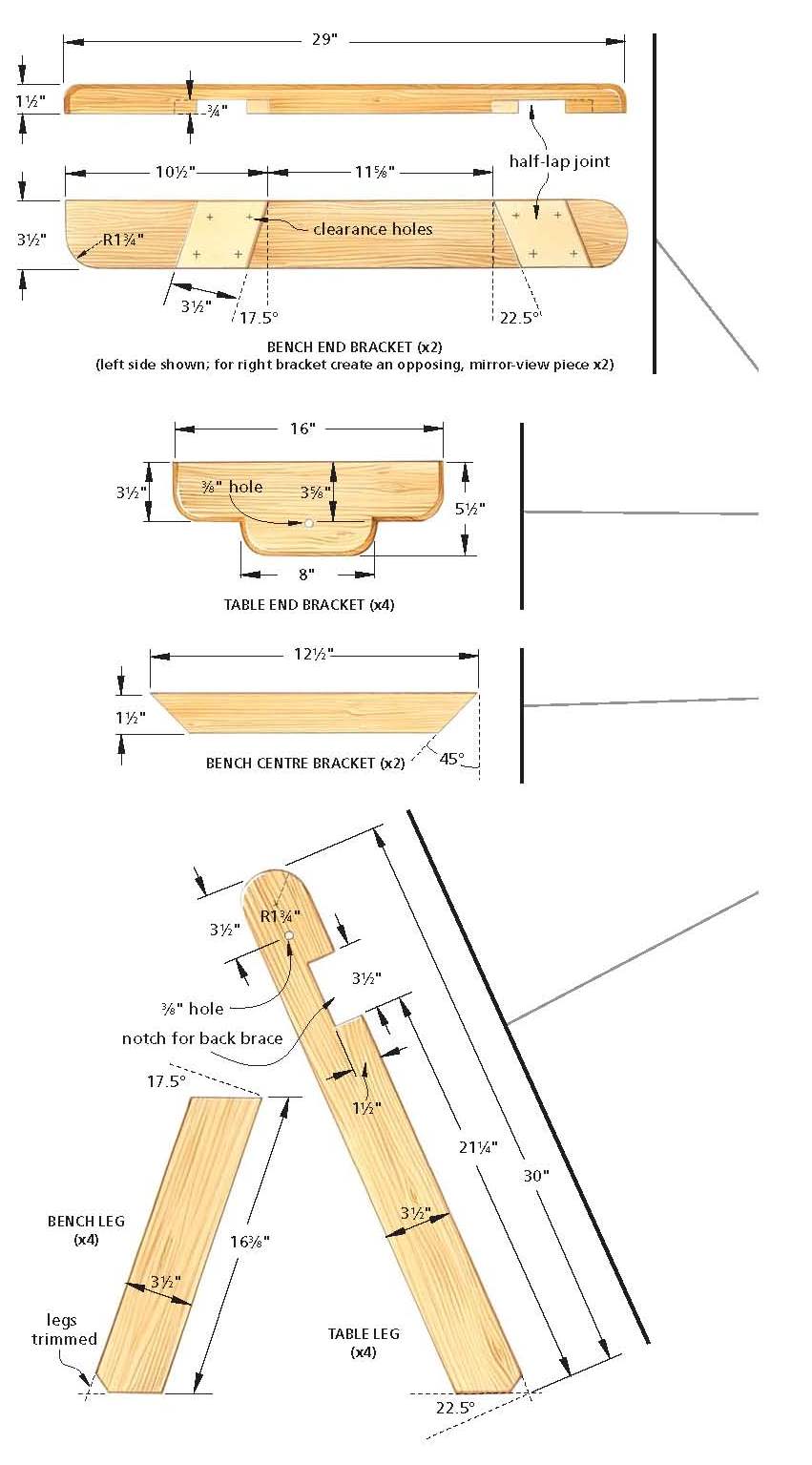
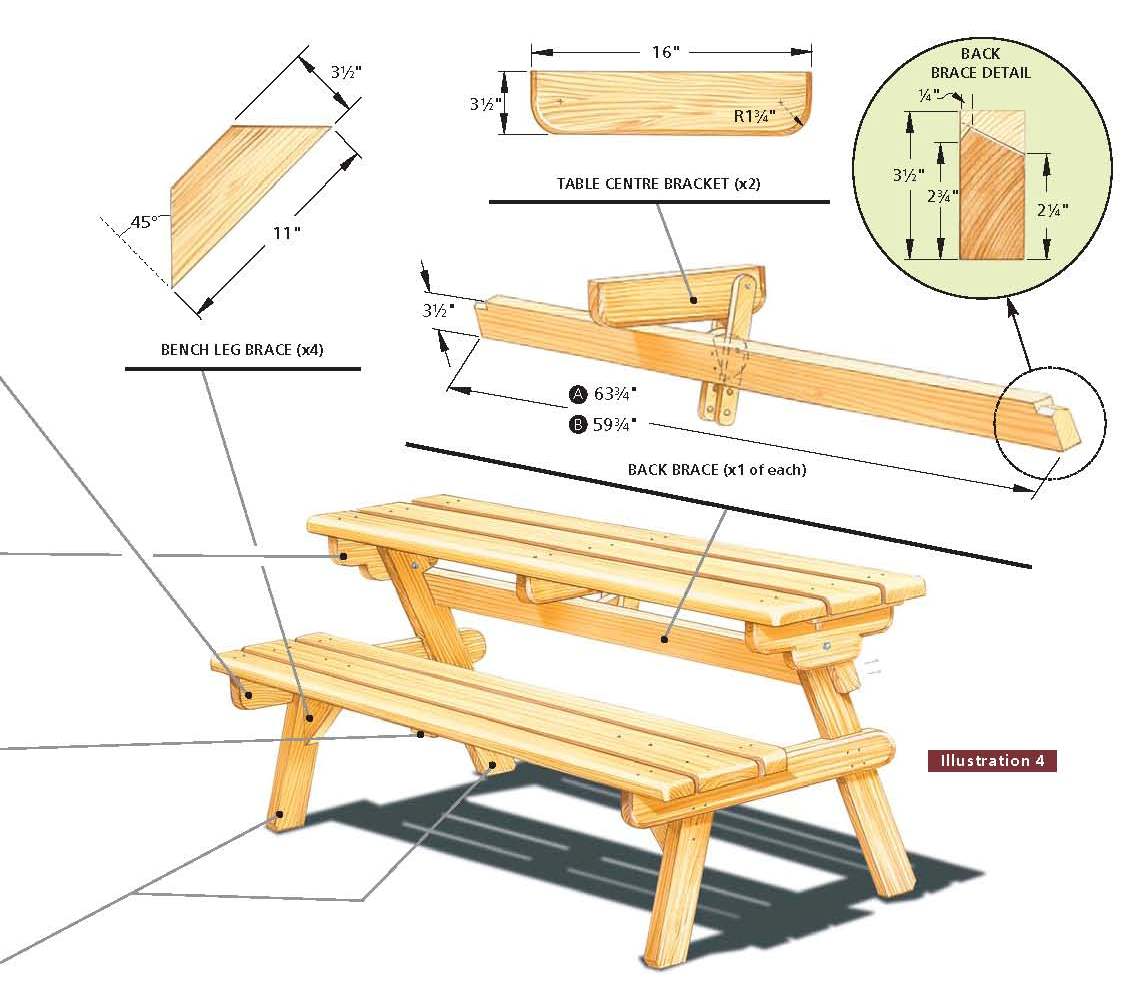 |
5.
Leaving the upper dowel in place, pull the swingarm
apart, sand, add glue to the pockets, and
reassemble. Screw the swingarm sides to the dowel
pieces with #6 x 1" screws. Use a rasp or surform to
adjust the fit of the middle dowel against the notch
in the bottom of each stop block (Illust. 6).
6. With the swingarm in place, drill a centred hole
through it and the stop block for the pin. (Precise
placement isn’t important: The pin is not
loadbearing; it functions simply to hold the
swingarm in place.) I made the pins from 3⁄8" x 8"
eye bolts. Cut the threaded portion off and taper
the ends with a flat file to remove sharp edges and
to make for a smoother fit. Though the threaded part
measures 3⁄8" in diameter, the smooth shank is
slightly smaller; start with a 21⁄64" hole. If that
is too tight, then move up to 11⁄32", and so on.
7. Pull the pin and slide the swingarm out. Tip the
tabletop into its bench position. Carefully cut a
new notch in the top of the stop block until the
bottom dowel can be seated securely (this will
prevent the bench back from moving). The notch must
be deep enough so that you can drill a second hole
through the bottom of the swingarms for the pin
(right-hand photo, opposite).
8. Run a 12" length of open-link light chain through
the eye of the pin, spread a link and hook it back
on itself, then close the link. Screw the other end
of the chain to the back brace with a #6 x 1" screw.
|
Free
Picnic Table Wood Plans
(Right Click on Image, and Select View as
Image or Save As to See the FULL SIZE
Picture)
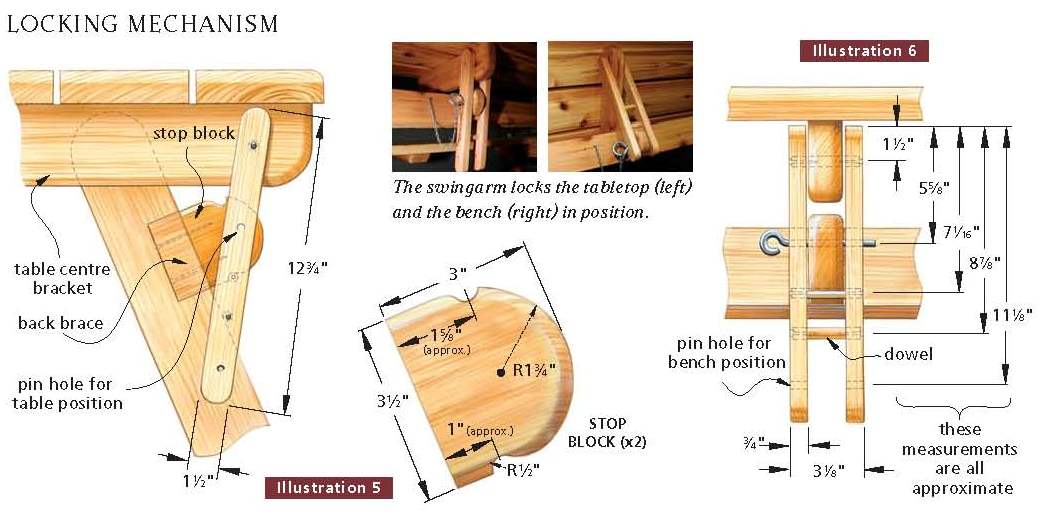
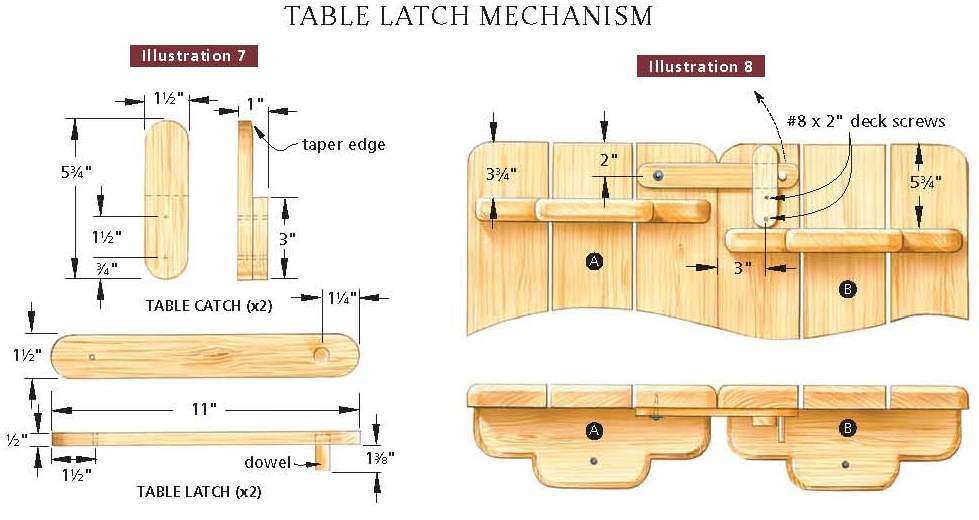 |
9. Swing
the tabletop back up and lock it into position.
Router the outside perimeter only of the tabletops (Illust.
2). I free-handed this operation, trying to be
careful not to run into the gaps, but a cedar shim
or a piece of 3⁄8" scrap plywood wedged into the gap
– flush to the top and end – will prevent the router
bit from wandering into this space. Sand.
TABLE LATCHES
A simple latch ensures that when the benches are
combined to form a single picnic table, the tabletop
surfaces stay together (Illust. 7 and 8, above). It
is nowhere near as inspired as the tabletop lock,
but it works. Rip 1⁄2"-thick strips of 2" x 4" for
the latches and the catches. A 13⁄4" piece of dowel
is recessed into the swinging latch arm. The
illustrations show how these are assembled. Tack the
catches together with 1" finishing nails. Use a #12
x 11⁄2" screw for the latch because it will resist
turning. (Note that the two tables should be
separated before you move them.)
FINISH
I finished the tables with two coats of Varathane
Natural Oil Finish. This product provides protection
from the elements and preserves the cedar’s terrific
appearance. It is also really easy to apply – ain’t
that a bonus!
|
Materials List
(for 2 benches) |
|
Part |
Cutting List |
QTY |
Material |
|
Tabletop boards |
2" x 6" x
71-1⁄2" |
2 |
2" x 6" x 12'
(x2) |
|
Center bench
boards |
2" x 6" x
71-1⁄2" |
2 |
|
Tabletop boards |
2" x 6" x
71-1⁄2" |
4 |
2" x 6" x 8'
(x4) |
|
Table end
brackets |
2" x 6" x 16" |
4 |
|
Back brace –
Bench A |
2" x 4" x 63
3⁄4" |
1 |
2" x 4" x 14'
(x1) |
|
Back brace –
Bench B |
2" x 4" x 59
3⁄4" |
1 |
|
Table center
brackets |
2" x 4" x 16" |
2 |
|
Table legs |
2" x 4" x 30" |
4 |
2" x 4" x 10'
(x6) |
|
Outside bench
boards |
2" x 4" x
71-1⁄2" |
4 |
|
Bench legs |
2" x 4" x
16-3⁄8" |
4 |
|
Bench end
brackets |
2" x 4" x 29" |
4 |
|
Bench leg braces |
2" x 4" x 11" |
4 |
|
Bench centre
brackets |
2" x 4" x
12-1⁄2" |
2 |
|
Stop blocks |
2" x 3" x 4" |
2 |
|
Swingarms |
3⁄4" x 1-1⁄2" x
12-3⁄4" |
4 |
ripped from 2" x
4" offcuts |
|
Table latches |
1⁄2" x 1-1⁄2" x
11" |
2 |
|
Table catches |
1⁄2" x 11⁄2" x
83⁄4" |
2 |
|
*All lumber is
premium western red cedar |
|
Hardware |
|
Deck screws |
#8 x 2" |
1 lb |
|
|
Deck screws |
#8 x 3" |
1 lb |
|
|
Wood Screws |
#6 x 1" |
14 |
|
|
Wood screws and
washers |
#12 x 11⁄2" |
2 |
|
|
Eye bolts |
3⁄8" x 8" |
2 |
|
|
Finishing nails |
1" |
4 |
|
|
Carriage bolts
with washers |
3⁄8" x 4" |
4 |
|
|
and compression
nuts |
|
|
|
|
Light open-link
chain |
1' |
2 |
|
|
Hardwood dowel |
1⁄2" x 2' |
1 |
|
|
Varathane
Natural Oil Finish |
|
2L |
|
|
Type II
carpenter’s glue |
|
|
|
|











